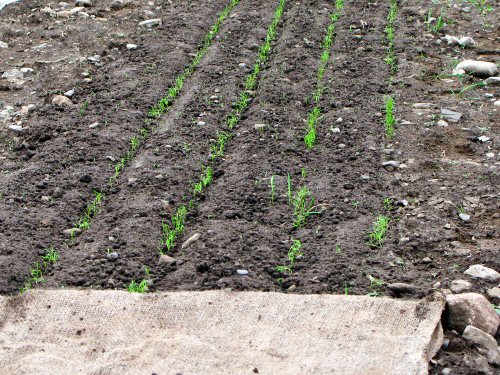Germinating carrots under a double layer of untreated burlap is the standard now, after last season’s successful trials. Here, a 50′ (15m) bed of Nelson turns out fine. And the burlap is holding up! It originally cost around $30US per bed, which is kinda real expensive if it disintegrated too quickly. But here it is, on the fourth or fifth planting with lots of life left in it. Anywhere under $10 a bed, and it’s way more cost-efficient than the extra watering and weeding that’d have to happen without it. Instead of rolling it up as I’d been doing, I folded this time, in half, and half again, and so on until it was in a neat, compact stack. Easier to handle, and easier to fold out next time around! And a weather note: Overnight, we suddenly slammed into some pretty intense heat. It was already warm and muggy when I stepped outside at 6:30am, and it shot up to around 30°C (90°F) during the day. Not nearly the hottest it can get around here, but with the humidity, it’s quite the shocking change from recent cooler weather. More of the same forecast for the next few days…





I LOVE this idea, and am just about to plant carrots and parsnips this weekend! I will get some burlap this morning and give it a try. I am really enjoying your blog, btw, I appreciate hearing about your experiences and thoughts behind your farming efforts. Growing food is very satisfying!
Best of luck for a great season!
Ali
I’ve been thinking really hard about burlap recently. I wonder if you can use it as a sort of sheet mulch instead of cardboard? I like that you can also use it for shade.
Katie: Thanks for reminding me of sheet composting. There are so many things I’d like to try to apply to the garden, ways to…transcend the rows-and-killing-all-weeds approach my field is so far based on. Burlap probably wouldn’t be good for the weed barrier layer, because it lets through a fair bit of light, and, layered, it would probably break down quite quickly (a couple of months?). It’s good as temporary mulch, for keeping in moisture and heat, especially for larger areas. For example, with carrots, they don’t need light to germinate, so one technique is to use boards to cover your seeded drills until germination. But hauling around hundreds of feet of board isn’t as practical as…burlap. It lets rain through, and blocks enough light to really slow down weeds, and you can fold it up when it’s done is bit.
First, I just wanted to say thanks for putting your experiences and thoughts out here for the rest of us to learn from and be inspired by. You’ve been a great help and encouragement to me as I trek down a similar road!
Second, what could burlap be treated with? Is there a way to tell if it is treated or not while you’re at the store looking at it, or does it require a call to the manufacturer?
Thanks!
have you ever had problems with leafminer in beet greens or swiis chard,spinach…..we seem to have this problem in our hoop house production area
Jessica: Thanks! I hope it turns out to be a good road for all of us!! For the burlap, I haven’t actually heard of treated burlap, but there is a lot of treated twine, so I was assuming burlap might be the same. You can get big, inexpensive spools of natural fibre twine, like jute or sisal, for hay baling and the like, but it’s usually treated with stuff to prevent rot and mildew, and to repel insects and rodents. Even if it’s not marked, you can sometimes tell because there’ll be an odd colored kinda powder. For organic certification standards, you can’t have any of that, untreated only, but aside from…rules, I just think untreated is safer if you’re covering seedlings or tying up tomatoes or whatever.
cathy: No, thankfully, no leafminer problems here. Nothing really bothers the beets and spinach in the field. And you’re not so far from me! :) I’m always so…grateful when I hear about other pests that I’ve so far had the same few basics: flea beetles, cucumber beetles, Colorado potato beetles, tomato hornworms…and I’ve managed to deal with ’em all reasonably well. Cutworms sound particularly scary… I know whenever I get to a production greenhouse, that’ll be a whole new, enclosed world of stuff to handle…